I have a problem with the way Mayor Soglin seems to be framing the issue of how to improve Ride the Drive. When the Mayor talks about the situation, he portrays it as a tension between the fun of the ride and a 20-45% loss in parking ramp revenue and business. But Ride the Drive has a purpose beyond simply creating a fun experience. That purpose is outlined in the following document (adopted on April 8th of 2008):
http://www.cityofmadison.com/trafficEngineering/documents/PlatinumAdopted040808sm.pdf
In the fall of 2006, then Mayor Dave Cieslewicz formed the Platinum Biking City Planning Committee with the overall goals of [pg. 1]:
1) achieving the Platinum designation level through the League of American Bicyclists Bicycle Friendly Communities program, and
2) putting forward a roadmap – or bike path – for Madison to become the best city in the country for bicycling.
One of their recommendations was “Institute a Sunday Parkways ride once per month.” This was the inspiration for Ride the Drive. The Platinum Report (Including the recommendation for Sunday Parkways) was adopted by the Common Council in April 8th of 2008. As originally envisioned Sunday Parkways are:
“times set aside on weekends and holidays for traffic-free biking and walking on a network of selected streets. In effect, streets are transformed into trails. Hundreds of thousands of cyclists use Sunday Parkways called Ciclovia in Bogotá, Columbia, and Via RecreActiva in Guadalajara, Mexico. Sunday Parkways do not impact motorized traffic flow like other special events, since all cross-traffic flows normally. Participants stop at all traffic signals, so that only the closed street is affected. Often on a divided arterial, the Sunday Parkway uses one half of the roadway and motorized traffic uses the other half. Sunday Parkways provide close-to-home recreational opportunities for all ages and all types of active travel.” [pg. 48]
But more importantly, the goal that Sunday parkways is meant to accomplish is to promote Education, Encouragement, and Outreach of topics related to bicycling and improving Madison’s bicycling infrastructure. While there is certainly room to improve the driving experience, are there other possible remedies to the decline in business revenues that also fulfill ride the drive’s purpose of promoting Education, Encouragement, and Outreach? Yes there are!
Imagine you are a business owner near a 2,000 space car-parking garage on a day when 20,000-50,000 bicyclists will be passing directly in front of your store. What is your greatest opportunity on such a day? Is it making sure all 2,000 car parking spaces (many of which may be empty because regular customers are participating in Ride the Drive) are full? If it was me, my priority would be finding a way to tap into that stream of 20,000-50,000 bicyclists passing by. Sadly, I did not see a whole lot of effort put into attracting bicyclists to state street stores at Ride the Drive this year (more on this at the end). I believe there are a number of things the City could do to help businesses attract more bicycle-customers during ride the drive.
So now imagine you are the Mayor with the Platinum Report adopted by the Common Council in hand, and you see that the goal of Ride the Drive is Education, Encouragement, and Outreach of bicycling. Your options to restore business revenues are to :
1) increase motor-vehicle mobility, and/or
2) facilitate more bicycle based commerce, and in the process educate bicyclists about how to shop by bike, and store owners of how to market to bicyclists.
In my mind, option two is a win-win for both businesses, and the goals of Ride the Drive, and it should be where the Mayor focuses the bulk of his effort. To help get that process started, here is a brief critique of the opportunities I saw during this year’s Ride the Drive:
I would expect businesses along the street to try to push their store right to the curb so it would be within easy reach of the slow-moving traffic passing by, but barely 1/10th of the businesses seemed to even bother to tap into the market available that day. The restaurant manager of Chuatara featured in a channel 3000 story demonstrates the poor attitude that I suspect most of the business owners have to this event: They set up for a slow day and left it at that.
Capital Kids was exemplary of how to do it right – they placed some displays right in the street outside their store to entice kids into their business. Ragstock, Mirage and Princess of India Imports also seemed to get it right by placing displays out on the sidewalk facing the street. There was also a woman handing out free tea from her business that seemed to be reaching out to the opportunity that day.
I believe the BID motor-vehicle access recommendations are premature, and fail to take into account the opportunities that state street businesses are neglecting to explore. I would recommend the city ignore anecdotes from all but the businesses that put in a reasonable effort – if those businesses didn’t see a benefit, then it may be time to see how we can augment the bike traffic with some other traffic. Otherwise, I think we should focus on giving help from the city in the form of space in the street for area businesses, taking down the outdoor seating areas for the day that I believe act as barriers for potential bicycle-based customers, and putting up additional temporary bicycle parking to ensure nobody passes a business by due to a lack of convenient parking.
How about a few images to illustrate my points?
(This is a good start, but how about instead of just a lifeless sign, we had some state street business reps handing out bike-friendly shopping bags that were easy to wear while riding? That would give people more of an incentive to stop at stores)
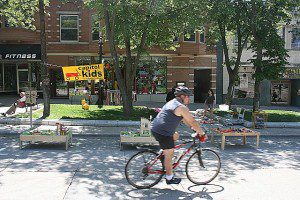 (Capitol Kids got it right with teaser displays right in the street and plenty of space to access them – though no immediately available bike parking is a problem.)
(Capitol Kids got it right with teaser displays right in the street and plenty of space to access them – though no immediately available bike parking is a problem.)
( The outdoor seating area barricades create a barrier for bicyclists who might otherwise visit a state street business – An outdoor ordering booth would make for a much more enticing experience. Note in the background, Chuatara also has a barricade, and offers no curbside service and had limited bike parking nearby )
(Ragstock got it right – nearby bike parking and teaser merchandise outside the store)
( Mirage’s proximity to bike parking makes it an ideal shop for bike shoppers , note they put some sales notices facing the street to attract bargain hunters on bicycles)
(Princess of India Imports had it right too – note the sales signs facing the street to entice bike shoppers )
( The Chocolate Shop seemed to be getting a lot of bicycle-based business at 2:30 on Sunday – despite the lack of adequate and convenient bike parking outside. Why can’t a store like this create a “drive-by”, where there is a station where one employee is taking orders and payment, the order gets called to the main desk, and run out to the curbfront? That would eliminate the hassle of trying to find limited bike parking while purchasing the ice cream, which should increase overall business for the day.)
(outside the chocolate shop – no outdoor presence and limited bike parking is limiting their ability to attract customers during Ride the Drive)
(Here’s a smart State Street business, who handed out free samples of tea (iced and warm) to passers by – I saw quite a few stop while I was there)
After the ride, I heard two interesting pieces of information. First, I talked to the Parks department, and they had been trying to organize businesses to donate “door” prizes as part of a promotional effort. It seems that only two businesses chose to participate, although the Mayor’s change to the route at the last minute (to facilitate better car access) may have prevented some businesses from participating . Second, I have heard (no offical confirmation though) that one of RTD’s sponsors offered to print coupons for State Street businesses, and that the business community turned that offer down.

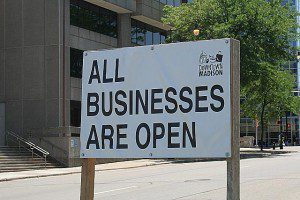
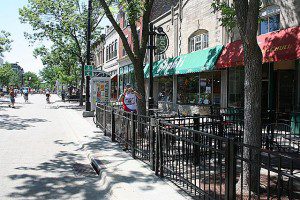
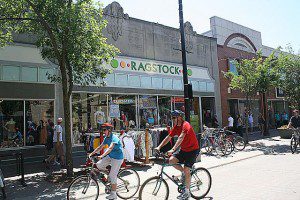
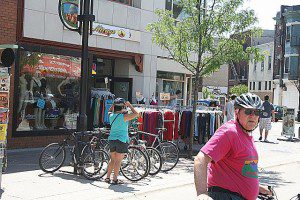
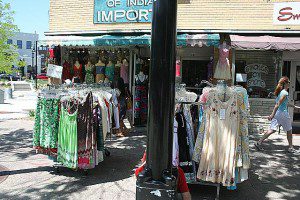
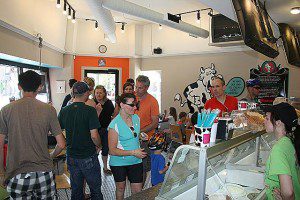
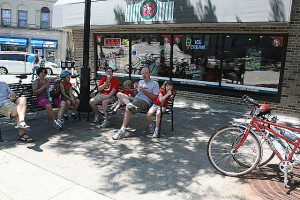
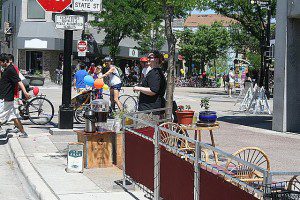




The photos in this piece support the concern about the bike ride. The archetype of a friendly Sunday bike ride is that of going to an ice cream shop so the Chocolate Shop getting business is a contrast to the empty streets the above photos show.
The writer of this piece has a problem with his interpretation of Soglin’s questioning as fun versus business. The writer then blames the businesses in an economy where businesses are suffering and need all of the help we can give them because in the end their taxes feed our community.
I have a problem with the dogma presented above as being the only way. Things change and need to be updated, and in town that rides bikes all over this idea is for the elite to come down to state street for a parade that no one shows.
Time to revamp and put it at the zoo.
Teresa,
The images were taken 30 minutes before the end of the Ride, and do not represent the average level of participation.
While it is true I am blaming businesses to a degree (Chautara specifically for “setting up for a slow day”), I blame the city more for not working with businesses to facilitate bicycle commerce during Ride the Drive. It is after all the City of Madison’s adopted policy to promote events like Ride the Drive as an opportunity to promote Education, Encouragement, and Outreach for bicycling, and therefore their responsibility to address business concerns in a way that is commensurate with those goals, rather than turning their backs on their own adopted plans (and the people who volunteered to serve on comittees and engage the process).
If the plan needs to be updated, it should be done in a thoughtful, deliberative way, keeping in mind the goals of the city and the needs of its citizens. It should not just be revamped and “put at the zoo” arbitrarily. I would also note that nothing I have suggested precludes improvements to the driving experience, it just prioritizes those options which are in line with the adopted Platinum Comittee report.
Finally, as a participant of several Ride the Drive events, I can assure you that there were very few (as a percentage of total participants) “elites” at the ride. That is, unless by “elites” you mean families.